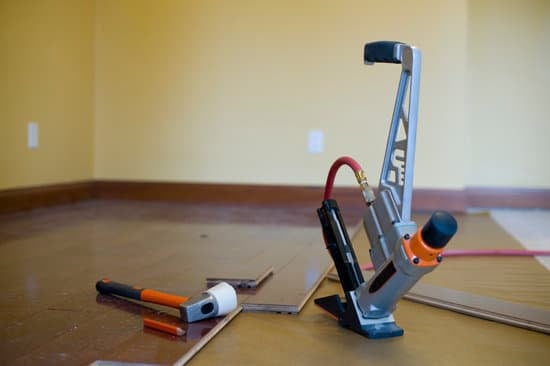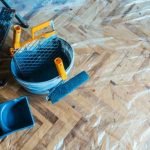In today’s fast-paced world, everyone strives to save money wherever possible. For homeowners, one way to achieve this is through tax deductions. Home improvements play a crucial role in maintaining property value and enhancing the overall living experience.
But can you claim home improvements on your tax return? This question has piqued the curiosity of many individuals seeking financial relief. In this article, we will delve into the world of tax deductions and explore the possibility of claiming home improvements on your tax return.
Tax deductions have long been a valuable tool for reducing the amount of taxes owed each year. Homeowners especially benefit from these deductions as they can offset some of their expenses by claiming eligible costs associated with their properties. While most people are familiar with deducting mortgage interest or property taxes, the concept of claiming home improvements on tax returns sparks particular interest. Are homeowners allowed to count renovations, repairs, or upgrades as deductible expenses?
To provide clarity on this matter, it is essential to understand the distinction between repairs and improvements for tax purposes. While both may contribute to a better living environment, repairs are considered necessary expenses to maintain the property’s current condition, whereas improvements enhance its overall value or adapt it to new uses. Knowing how these two categories differ in terms of taxation can help homeowners determine which expenses may be eligible for deduction.
With curiosity piqued and differentiation clarified, it becomes crucial to examine under what conditions homeowners can claim home improvements on their tax returns. Understanding the eligibility criteria ensures that one does not mistakenly claim ineligible expenses while maximizing potential deductions available. By exploring these qualifications thoroughly, homeowners gain insight into whether they qualify and can plan accordingly when undertaking improvement projects.
Stay tuned as we dive deeper into understanding what qualifies as home improvements for tax purposes in subsequent sections.
The Difference Between Repairs and Improvements
When it comes to tax deductions for home-related expenses, it is important to understand the difference between repairs and improvements. While both types of expenses can improve the condition of your home, they are treated differently for tax purposes.
Repairs are considered regular maintenance tasks that keep your property in good working order. These can include fixing a leaky faucet, patching a hole in the roof, or replacing a broken window. Generally, repairs are fully deductible in the year they are incurred.
On the other hand, home improvements are considered upgrades that add value to your property or prolong its useful life. These can include major renovations like adding a room, remodeling a kitchen, or installing energy-efficient windows. Home improvements generally need to be capitalized and depreciated over time rather than being fully deductible in the year they are completed.
To distinguish between repairs and improvements for tax purposes, the IRS has provided guidelines. According to these guidelines, an expense is considered an improvement if it:
- Adds value to your home.
- Extends the useful life of your home.
- Adapts your home to new uses.
To determine whether an expense qualifies as a repair or improvement, consider its scale and scope as well as its effect on the functionality and value of your home.
It is essential to correctly categorize your expenses as either repairs or improvements when claiming them on your tax return. Failing to do so can result in incorrect deductions or even potential audits from the IRS. To ensure accuracy and maximize your tax benefits, consult with a tax professional who can provide guidance specific to your situation and help you navigate the complex rules surrounding deductibility of home-related expenses.
Eligibility Criteria
One of the first questions homeowners have when considering whether they can claim home improvements on their tax return is whether they are eligible to do so. Understanding the eligibility criteria is crucial in determining if you can take advantage of tax deductions for your home improvement expenses. Here are the main conditions that homeowners should meet in order to be eligible for claiming home improvements on their tax return:
- Primary Residence: The home that underwent the improvements must be your primary residence, meaning that you live in it for most of the year. Second homes, rental properties, or vacation homes may not qualify for these tax deductions.
- Capital Improvement: The improvement made to your home must be deemed a capital improvement by the IRS. This means that it must increase the value of your home or extend its useful life. Examples of capital improvements include adding a new room, replacing roofing or flooring, installing a new heating or cooling system, or making significant landscaping changes.
- Original Use Requirement: The improvement must also be made to a property that is already in use and not a new construction. Therefore, if you are building a completely new house or adding an entirely new structure to an existing property, those costs would not qualify as tax-deductible home improvements.
- Itemization of Deductions: In order to claim any home improvement expenses on your tax return, you must itemize your deductions instead of taking the standard deduction. Itemizing allows you to provide detailed information about your qualifying expenses and potentially maximize your overall deductions.
It is important to note that there may be additional specific requirements and limitations depending on individual circumstances and local regulations. Homeowners who believe they meet these general eligibility criteria should consult with a qualified tax professional or refer to IRS guidelines for further guidance tailored to their unique situation.
| Eligibility Criteria | Conditions |
|---|---|
| Primary Residence | The home that underwent the improvements must be your primary residence. |
| Capital Improvement | The improvement must increase the value of your home or extend its useful life. |
| Original Use Requirement | The improvement must be made to a property that is already in use and not new construction. |
| Itemization of Deductions | Homeowners must itemize their deductions instead of taking the standard deduction. |
Qualified Home Improvements
One of the key factors in determining whether homeowners can claim home improvements on their tax return is identifying which improvements qualify for tax deductions. The IRS has specific criteria that must be met in order for a home improvement to be eligible for a deduction. Here is a comprehensive list of qualified home improvements that can potentially be claimed on your tax return:
- Energy-Efficient Upgrades: Installing energy-efficient windows, doors, roofing, insulation, or HVAC systems may qualify for tax credits under certain circumstances. These upgrades not only help reduce energy consumption and lower utility bills but also offer potential tax savings.
- Accessibility Modifications: Homeowners who make modifications to their homes to accommodate individuals with disabilities may be eligible for tax deductions. This can include adding ramps, widening doorways, installing grab bars, or making other accessibility-related changes.
- Renewable Energy Systems: Investing in renewable energy systems such as solar panels or wind turbines may qualify homeowners for federal and state tax credits. These incentives aim to encourage the use of clean and sustainable energy sources.
- Home Office Expenses: If you have a dedicated space in your home used exclusively for business purposes, you may be able to claim expenses related to the maintenance and improvement of that space. This can include repairs or renovations done to your home office area.
- Safety Enhancements: Home improvements made for safety purposes may also potentially qualify for deductions. Examples may include installing a security system, fire alarms, sprinkler systems, or storm shutters.
It’s important to note that not all home improvements will automatically result in tax deductions. It is crucial to consult the IRS guidelines and seek professional advice from a qualified tax professional before making any claims on your tax return.
| Qualified Home Improvements | Description |
|---|---|
| 1. Energy-Efficient Upgrades | Installing energy-efficient windows, doors, roofing, insulation, or HVAC systems. |
| 2. Accessibility Modifications | Making changes to the home to accommodate individuals with disabilities, such as adding ramps or widening doorways. |
| 3. Renewable Energy Systems | Investing in renewable energy systems like solar panels or wind turbines. |
| 4. Home Office Expenses | Deducting expenses related to maintaining and improving a dedicated home office space. |
| 5. Safety Enhancements | Installing security systems, fire alarms, sprinkler systems, or storm shutters for safety purposes. |
Documenting Expenses
The Importance of Documentation
When it comes to claiming home improvements on tax returns, proper documentation is crucial. It serves as evidence to support your claims and can help you avoid any potential audits or disputes with the IRS. Maintaining accurate and detailed records of your expenses is essential for ensuring that you receive the maximum tax deductions you are eligible for.
Types of Documents to Keep
To document your home improvement expenses, it is important to keep a variety of records. Here are some examples of documents you should maintain:
- Receipts: Keep all receipts related to the materials and supplies purchased for your home improvement projects. This includes invoices from contractors, retailers, and suppliers.
- Contracts: If you hired professionals or contractors for the home improvements, make sure to keep copies of all contracts and agreements.
- Permits and Licenses: If permits or licenses were required for your home improvements, keep copies of these documents as well.
- Before-and-After Photos: Taking photos before and after the improvements can be useful in proving the extent of the changes made to your home.
- Bank Statements: Keep copies of bank statements showing payments made for the home improvements. This will help verify that you actually incurred the expenses.
Recordkeeping Tips
Proper recordkeeping can save you time and stress when it comes time to file your tax return. Here are some tips to help you stay organized:
- Create a designated folder or digital folder specifically for home improvement documentation.
- Label each document clearly with relevant information such as purchase dates, descriptions, and amounts.
- Consider using accounting software or apps specifically designed for documenting expenses.
- Regularly review and reconcile your records to ensure accuracy.
- Store digital copies of important documents in a secure location or cloud storage platform.
By following these tips and maintaining thorough records, you will be better prepared to claim home improvements on your tax return and maximize your eligible deductions. Remember, consulting with a tax professional can provide you with further guidance on how to properly document your expenses and ensure compliance with IRS regulations.
Tax Deduction Limits
Tax deduction limits for home improvements
When it comes to claiming tax deductions for home improvements, homeowners should be aware that there are some limitations on the amount they can deduct. These limits are determined by the Internal Revenue Service (IRS) and can vary depending on several factors, including the type of improvement and the taxpayer’s income level.
Qualifying for tax deductions
To qualify for tax deductions on home improvements, homeowners must meet certain criteria set by the IRS. These criteria include using a portion of their home for business or rental purposes, making energy-efficient improvements, or installing medically necessary upgrades. It’s important for homeowners to consult with a tax professional to determine if their particular home improvement projects meet the eligibility requirements.
Energy-efficient improvements
For energy-efficient improvements, such as solar panels or geothermal systems, homeowners may be eligible for a tax credit rather than a deduction. Tax credits directly reduce the amount of tax owed, providing even greater financial benefits. However, homeowners should note that these credits often have their own sets of eligibility criteria and documentation requirements.
Home office deductions
If a homeowner uses part of their residence exclusively as a home office, they may qualify for additional tax deductions related to home improvements made in that area. However, it is essential to carefully follow IRS guidelines regarding what counts as a deductible expense and maintain accurate records to support these claims.
Medical necessity deductions
For homeowners making improvements to accommodate medical needs or disabilities, certain expenses may be deductible. These might include modifications like ramps, wider doorways, or accessible bathrooms. However, it is crucial to keep detailed records of these expenses and consult with a tax professional to ensure compliance with IRS regulations.
Overall, understanding the tax deduction limits for home improvements is essential before attempting to claim any expenses on your tax return. By being knowledgeable of the criteria and documentation requirements, homeowners can maximize their eligible deductions and potentially save significant amounts on their taxes. It is always recommended to consult with a tax professional for accurate guidance tailored to individual circumstances.
Understanding the Tax Form
When it comes to claiming home improvements on your tax return, understanding the tax form is crucial. Here is a step-by-step guide on how to navigate the tax form and claim your eligible home improvements.
- Determine the appropriate form: The first step is to determine which tax form you should use. Most homeowners will use Form 1040, also known as the U.S. Individual Income Tax Return. However, if you are a business owner or real estate professional, you may need to use different forms such as Form 1065 or Schedule C.
- Complete Schedule A: Once you have identified the correct form, you will need to complete Schedule A – Itemized Deductions. This schedule allows you to report various deductions, including your home improvement expenses.
- Enter relevant information: On Schedule A, look for the section labeled “Other Miscellaneous Deductions.” This is where you will enter your eligible home improvement expenses. Be sure to accurately describe each expense and provide supporting documentation such as receipts and invoices.
- Calculate your deduction: After entering all your home improvement expenses in the appropriate section of Schedule A, add them up and calculate the total amount of your deduction. Remember that only qualifying home improvements can be claimed, so refer back to the list outlined earlier in this article.
It’s important to note that homeowners who wish to claim home improvements on their tax return should keep detailed records of their expenses and any related documents that support their claims. This may include receipts, contracts, invoices, and before-and-after photos of the completed improvements. By maintaining organized records, taxpayers can substantiate their claims and avoid potential issues during an audit.
Case Studies
When it comes to claiming home improvements on tax returns, hearing about real-life examples can provide valuable insights and inspiration. Here are a few case studies that showcase how homeowners have successfully claimed home improvements and benefited from tax deductions:
1. Sarah’s Energy-Efficient Upgrades:
Sarah decided to invest in energy-efficient upgrades for her home, including installing solar panels and upgrading her insulation. As a result, she was able to claim a substantial tax deduction for these qualified home improvements. By maintaining detailed documentation of her expenses and consulting with a tax professional, Sarah was able to receive significant tax savings while also making her home more environmentally friendly.
2. Michael’s Home Office Conversion:
Michael decided to convert a spare room in his house into a dedicated home office space. He installed built-in shelves, upgraded the lighting fixtures, and added soundproofing materials for better acoustics.
Since this conversion was necessary for his work as a freelance writer, Michael was able to claim these expenses as eligible home improvements on his tax return. By properly documenting the costs of materials, labor, and invoices from contractors, he received a considerable tax deduction for the improvement expenses involved in creating his home office.
3. Laura’s Accessibility Renovations:
Laura needed to make her home wheelchair accessible due to a family member’s mobility issues. She made modifications such as widening doorways, adding ramps, and installing bathroom grab bars. These accessibility renovations were deemed eligible home improvements by the IRS since they improved the quality of life for individuals with disabilities. Laura gathered all necessary receipts and invoices related to the construction work and was able to claim a substantial tax deduction.
These case studies highlight the potential benefits of claiming home improvements on your tax return. However, it’s important to note that each taxpayer’s situation is unique, and eligibility and deductions can vary depending on factors such as income level, type of improvement, and local regulations. Therefore, it is crucial to consult with a tax professional who can provide personalized advice based on your specific circumstances.
In the next section, we will delve into the potential risks and precautions that homeowners should be aware of when claiming home improvements on their tax returns, along with proactive measures to minimize these risks.
Potential Risks and Precautions
POTENTIAL RISKS AND PRECAUTIONS: Discussing the potential risks or pitfalls homeowners might encounter when claiming home improvements on their tax returns, along with proactive measures to minimize such risks.
While claiming home improvements on your tax return can lead to significant deductions and potential savings, homeowners should be aware of the potential risks and pitfalls associated with this process. Failing to navigate these risks properly can result in audits, penalties, or even legal consequences. Therefore, it is crucial to understand these risks and take proactive measures to minimize them.
One common risk when claiming home improvements is not being able to adequately prove that the expenses incurred were indeed for qualified improvements. Documentation is key in substantiating your claims. Homeowners should maintain careful records of all receipts, invoices, contracts, and other relevant documents relating to their home improvements. It is advisable to keep these records organized and easily accessible in case of an audit or verification by the Internal Revenue Service (IRS).
Another risk homeowners may face is incorrectly categorizing expenses as home improvements instead of repairs. Remember that only qualified home improvements are eligible for tax deductions. Ordinary repairs that are considered routine maintenance or restore a property’s original condition do not qualify. Misclassifying expenses could potentially trigger an audit or result in penalties if discovered by the IRS during a review.
To minimize these risks, it is advisable for homeowners to consult with a tax professional knowledgeable about home improvement deductions and the specific regulations set forth by the IRS. A tax professional can provide guidance on which expenses qualify as home improvements and assist in properly documenting expenses to support your claims.
In addition to seeking professional advice, homeowners can take several precautions themselves. Keeping detailed photographic evidence of the before-and-after conditions of their property after each improvement can serve as powerful supporting documentation. Additionally, preserving any permits or certificates obtained for construction work done also helps legitimize your claim.
By understanding and proactively addressing these potential risks and taking appropriate precautions, homeowners can maximize their chances of successfully claiming home improvements on their tax returns. Remember, compliance with tax laws and regulations is vital, and seeking professional advice is always recommended to ensure accuracy and legality when it comes to claiming deductions for home improvements.
Conclusion
In conclusion, understanding the rules and regulations surrounding claiming home improvements on tax returns is essential for homeowners. By distinguishing between repairs and improvements, homeowners can accurately determine if their expenses qualify for tax deductions. It is important to remember that not all home improvements are eligible, and certain criteria must be met in order to claim them on a tax return.
Maintaining thorough documentation of all expenses is crucial when it comes to supporting claims on tax returns. Homeowners should keep receipts, invoices, and other relevant records to substantiate their deductions. By doing so, they can ensure that their claims are legitimate and avoid any potential issues with the IRS.
While there are limits to the amount of tax deduction homeowners can expect for qualifying home improvements, consulting with a tax professional can provide accurate guidance on navigating the complexities of the process. Tax professionals have expertise in this area and can help homeowners maximize their deductions while minimizing any potential risks or pitfalls.
Frequently Asked Questions
What home improvements are tax deductible IRS?
The IRS does not typically allow for a deduction on home improvements. However, there are some instances where certain home improvements can be tax-deductible. For example, if the improvement is necessary for medical reasons and specifically prescribed by a doctor, it may be eligible as a medical expense deduction.
Another potential deduction can come from selling your home at a profit – you can subtract the cost of certain improvements made to increase its value from the capital gains. It’s important to consult with a tax professional or refer to IRS guidelines for specific details on qualifying deductions.
What are the tax breaks for home improvements in 2023?
As of now, there are no specific tax breaks announced for home improvements in 2023. Tax laws and regulations are subject to change, so it’s advisable to stay updated with any potential changes that may occur before making assumptions about upcoming tax breaks.
Changes in government policies and economic conditions can affect future tax incentives related to home improvements. Keeping an eye on official IRS publications and seeking advice from tax professionals will help ensure accurate information about tax breaks in 2023 or any other year.
What happens if you don t have receipts for home improvements?
If you don’t have receipts for your home improvements, it becomes challenging to prove the costs incurred and substantiate them for various purposes like potential deductions or warranty claims. While lacking receipts doesn’t necessarily mean you’ll automatically lose out on benefits, it definitely makes things more complicated when dealing with the IRS or insurance companies.
In such cases, alternative documentation becomes crucial – bank statements showing payments made to contractors or suppliers, signed contracts, cancelled checks, credit card statements with relevant transactions, photographs of before-and-after renovation work – these can serve as evidence of expenses incurred during home improvements when traditional receipts are not available. However, keeping organized records and retaining receipts whenever possible is generally recommended to simplify future proceedings and meet requirements set by authorities or insurers.

I’m thrilled to have you here as a part of the Remodeling Top community. This is where my journey as an architect and remodeling enthusiast intersects with your passion for transforming houses into dream homes.





